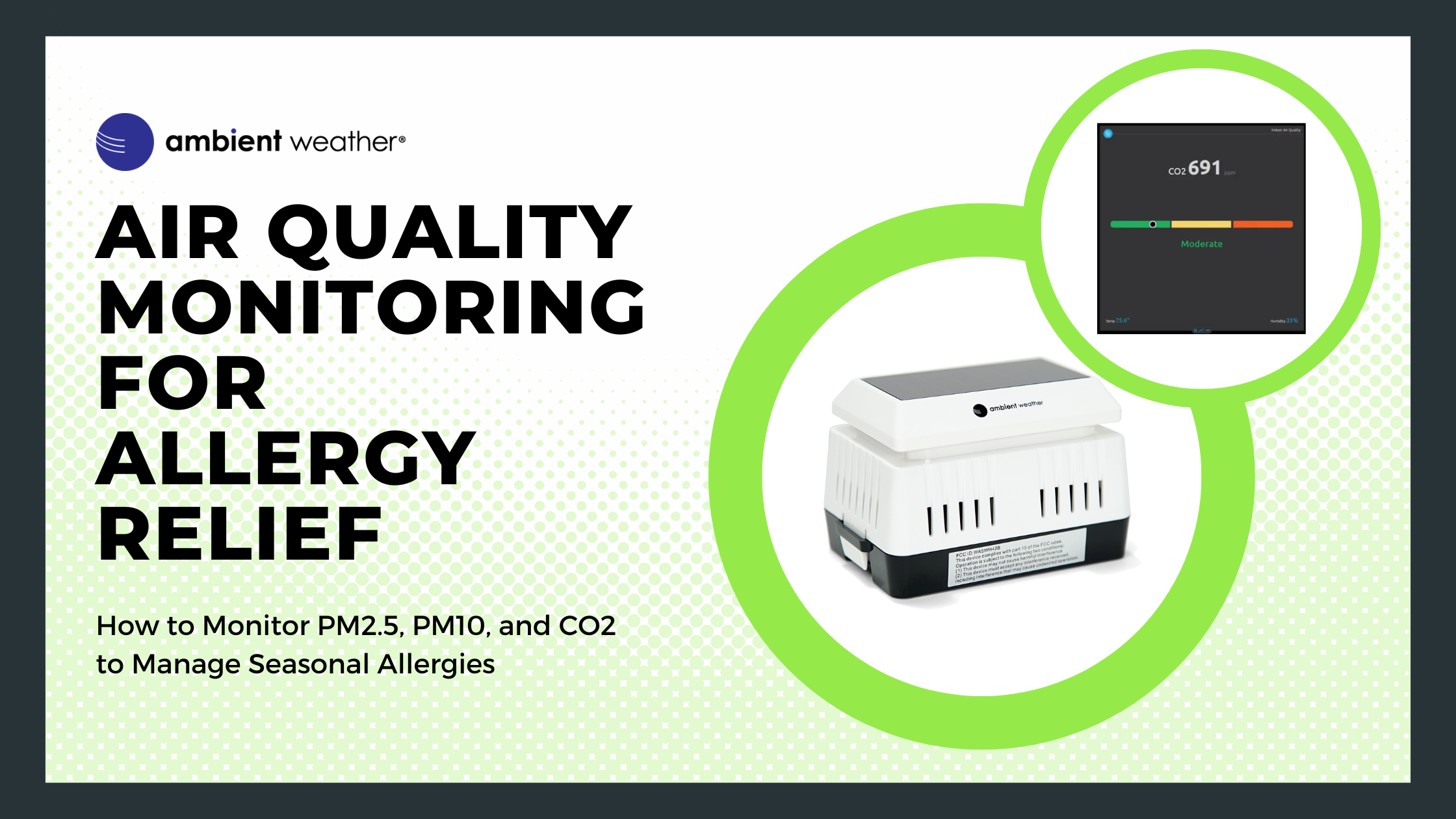How to Monitor Air Quality to Reduce Allergy Symptoms

If you suffer from seasonal allergies, you're not alone—and you're not powerless. One of the most effective ways to manage allergy symptoms is to monitor and improve your air quality. Let's explore how air quality monitoring works and how to find the right sensor to help you breathe easier at home.
What Is Air Quality Monitoring?
Air quality monitoring is the process of measuring the presence of pollutants like particulate matter and gases in the air around you, both indoors and outdoors. These pollutants can affect how you feel day to day, especially if you suffer from allergies. Understanding what's in your air helps you take action to create a healthier space for you and your family.
Ambient Weather makes this simple with sensors that connect to your Ambient Weather Station and the Ambient Weather Network (AWN). These devices provide real-time data on particulate matter (PM2.5 and PM10) and carbon dioxide (CO2) levels, so you always know what you're breathing and when it's time to take action.
PM2.5: How It Affects Your Allergies
PM2.5 refers to fine particulate matter less than 2.5 micrometers in diameter—about 30 times smaller than a human hair. These microscopic particles can travel deep into your lungs and even enter your bloodstream.
Allergy-related sources of PM2.5 include:
- Pollen fragments
- Smoke from wildfires or fireplaces
- Pet dander and dust mites
- Vehicle and industrial emissions
Monitoring PM2.5 levels is crucial because it allows you to assess the air quality and understand potential health risks associated with high concentrations of these harmful particles.
PM10: Why Allergy Suffers Should Track It
PM10 refers to particulate matter that is 10 micrometers or smaller in diameter. These particles are larger than PM2.5 but still small enough to be inhaled. When PM10 levels are elevated, they can irritate the respiratory system and exacerbate existing respiratory conditions.
PM10 includes common allergens such as:
- Pollen from trees, grasses, and weeds
- Mold spores
- Dust kicked up by wind or construction
Monitoring PM10 gives you a more complete view of allergy risks in your environment, especially during spring and fall allergy seasons.
CO2: A Clue to Indoor Air Quality
CO2, or carbon dioxide, is a naturally occurring gas that we exhale when we breathe. In low concentrations, it's harmless, but when CO2 levels build up indoors due to poor ventilation, it can lead to a stale, stuffy environment. While CO2 itself is not an allergen, elevated levels often indicate insufficient air circulation, which can cause allergens like dust mites, mold, and dander to accumulate.
Measuring CO2 helps ensure your indoor air is circulating properly, reducing irritation and promoting better breathing.
Which Sensor Is Right for Allergy Relief?
Indoor PM2.5 Monitoring
The Ambient Weather PM25IN® Wireless Indoor Particulate Monitor is designed to track PM2.5 levels inside your home. By tracking indoor air quality changes, you can respond quickly to increases in allergens and maintain a healthier breathing environment.
Compatibility: The PM25IN Monitor works with Ambient Weather Models WS-1965, WS-2000, WS-2902C, WS-4000, WS-5000, and the OBSERVERIP Module (WS-0800-IP, WS-0900-IP, WS-1200-IP, WS-1400-IP, WS-1550-IP, WS-1600-IP, WS-5000-IP).
Outdoor PM2.5 Monitoring
The Ambient Weather PM25® Wireless Outdoor Particulate Monitor measures PM2.5 levels outside your home. Knowing when outdoor air quality dips let you avoid flare-ups by limiting outdoor exposure or closing windows to keep pollutants from entering your home.
Compatibility: The PM25 Monitor works with Ambient Weather Models WS-1965, WS-2000, WS-2902C, WS-4000, WS-5000, and the OBSERVERIP Module (WS-0800-IP, WS-0900-IP, WS-1200-IP, WS-1400-IP, WS-1550-IP, WS-1600-IP, WS-5000-IP).
Full-Spectrum Indoor Monitoring
For complete allergy support, choose the Ambient Weather AQIN Air Quality Particulate Monitor. It tracks PM2.5, PM10, and CO2 levels, offering a full picture of your indoor air.
Effortlessly monitor your air quality on your Ambient Weather Network (AWN) dashboard and set alerts for unfavorable conditions.
Breathe Easier, Starting Now
With Ambient Weather's air quality monitoring tools, you can take charge of your environment and reduce allergy triggers before they affect your health. From pollen and dust to smoke and CO2, our sensors give you the data you need to breathe easier.







